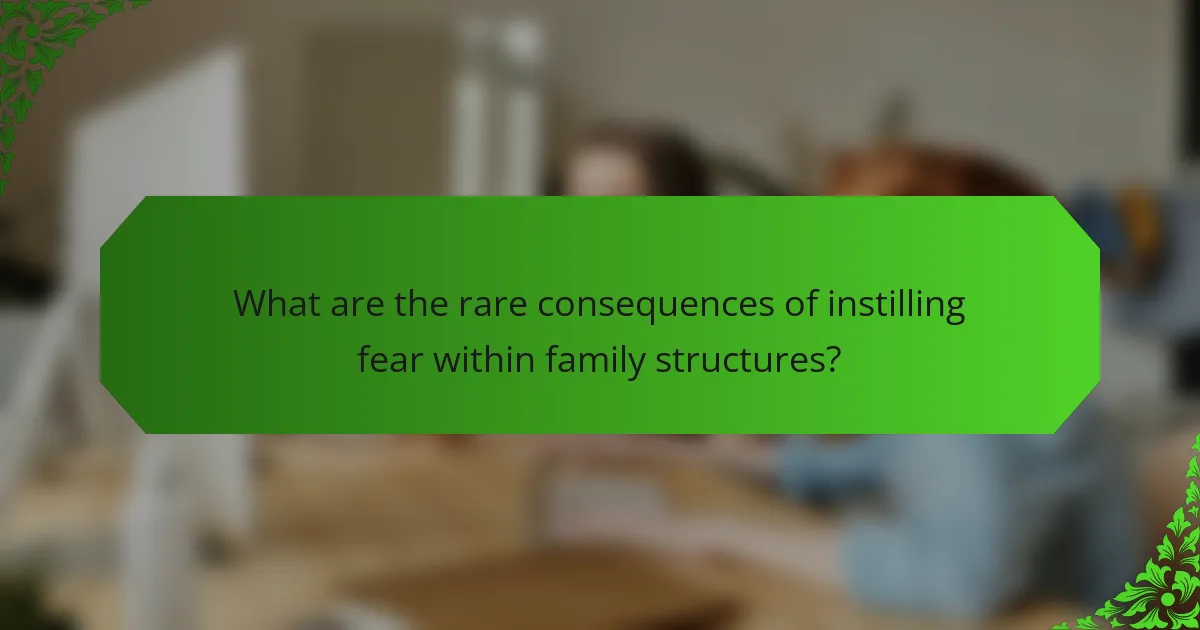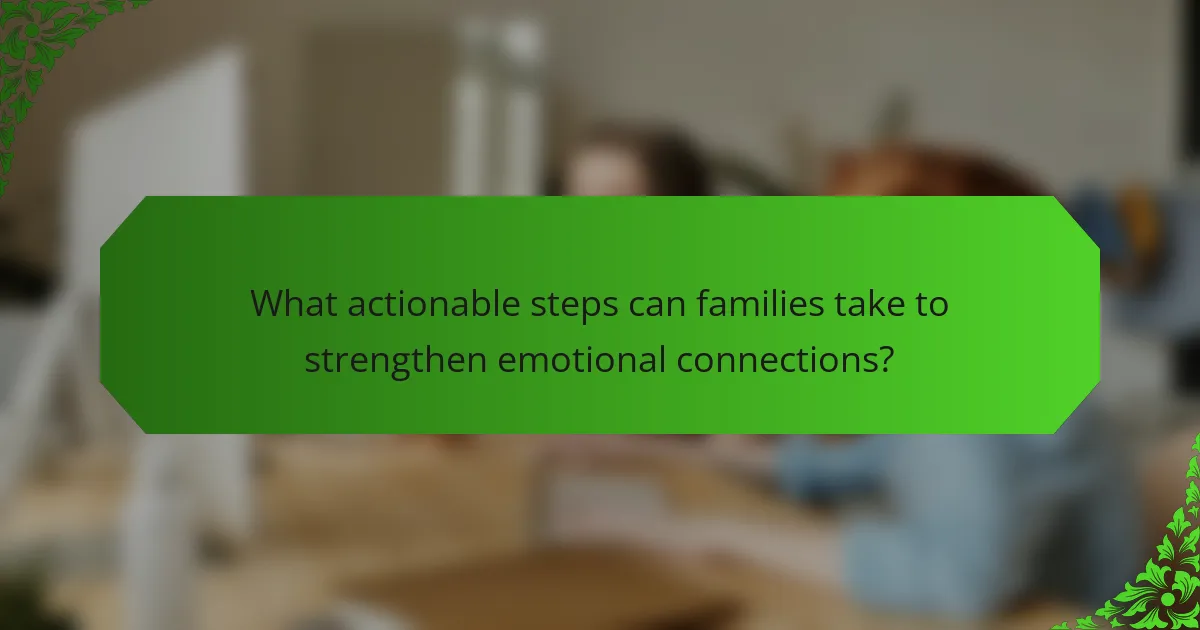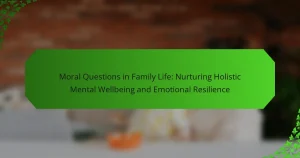The question of whether it is better to be loved or feared significantly impacts family bonds and emotional health. Love fosters trust and security, enhancing relationships and overall well-being. In contrast, fear creates anxiety and distance, undermining genuine connections. This article explores the benefits of love, the consequences of fear, and effective strategies for nurturing emotional security within family dynamics.

What are the emotional impacts of being loved versus being feared?
Being loved fosters emotional well-being, while being feared often leads to anxiety. Love promotes trust and security, enhancing family bonds and emotional health. Fear can create a toxic environment, leading to stress and isolation. Studies show that love increases resilience and overall happiness, whereas fear can lead to negative psychological effects. Prioritizing love over fear is essential for nurturing healthy relationships and emotional stability.
How do love and fear influence family dynamics?
Love fosters trust and connection, while fear can create compliance but often leads to resentment. Family dynamics thrive on love, promoting emotional health and resilience. In contrast, fear may produce immediate obedience but undermines long-term relationships. Studies show that families characterized by love exhibit stronger bonds and better communication, enhancing overall well-being.
What role does attachment theory play in family relationships?
Attachment theory significantly influences family relationships by shaping emotional bonds and communication styles. Secure attachment fosters trust and openness, while insecure attachment can lead to conflict and emotional distance. Research indicates that families with secure attachments exhibit healthier emotional health, enhancing overall family dynamics. Understanding these attachment styles can guide interventions aimed at improving relationships and emotional well-being within families.
What are the types of attachment styles?
There are four main types of attachment styles: secure, anxious, avoidant, and disorganized. Each style significantly influences emotional health and family bonds. Secure attachment fosters trust and healthy relationships. Anxious attachment often leads to dependency and fear of abandonment. Avoidant attachment promotes emotional distance and self-reliance. Disorganized attachment combines elements of both anxious and avoidant styles, resulting in confusion and instability in relationships. Understanding these styles can enhance emotional well-being and strengthen family connections.
How can attachment styles affect emotional health?
Attachment styles significantly influence emotional health by shaping how individuals relate to others. Secure attachment fosters healthy relationships and emotional resilience, while insecure styles can lead to anxiety and difficulties in managing emotions. Research indicates that individuals with secure attachment are more likely to experience positive emotional outcomes. In contrast, those with avoidant or anxious attachment may struggle with trust and intimacy, affecting overall emotional well-being. Understanding these dynamics can enhance personal growth and improve interpersonal connections.

What are the universal benefits of love in family settings?
Love in family settings fosters emotional security, improves mental health, and strengthens relationships. It enhances communication, promotes resilience, and encourages positive behavior. Families that prioritize love experience greater cohesion and support, leading to overall well-being. Studies show that children raised in loving environments develop higher self-esteem and better social skills.
How does love foster emotional security in children?
Love fosters emotional security in children by providing a stable environment where they feel valued and understood. This emotional safety promotes healthy development and resilience. When children experience love, they build trust and confidence, essential for forming healthy relationships. Research indicates that secure attachment, rooted in love, leads to better emotional regulation and social skills. In contrast, fear can lead to anxiety and hinder emotional growth. Thus, love is vital for nurturing emotional health in children.
What are the long-term effects of a loving environment?
A loving environment fosters emotional resilience and promotes mental well-being over the long term. Individuals raised in such settings often experience lower levels of anxiety and depression, leading to healthier relationships. Studies indicate that children from nurturing families develop better coping mechanisms and higher self-esteem. As a result, they are more likely to thrive in social and professional settings, demonstrating the profound impact of love on emotional health.

What unique attributes differentiate love from fear in family interactions?
Love fosters trust and connection, while fear creates distance and anxiety in family interactions. Love promotes open communication, enhancing emotional health. In contrast, fear may lead to compliance but undermines genuine relationships. Families that prioritize love experience stronger bonds and resilience. Fear can result in conflict and emotional strain, ultimately harming family dynamics.
How does the perception of authority impact family relationships?
The perception of authority significantly influences family relationships, often shaping dynamics and emotional health. Families where authority is perceived as nurturing foster open communication and trust. In contrast, those where authority is viewed as controlling may experience fear, leading to strained connections. Research indicates that balanced authority, characterized by both love and respect, promotes healthier emotional bonds. Establishing authority through empathy rather than fear enhances family resilience and cohesion.
What unique benefits does a nurturing approach provide?
A nurturing approach fosters emotional security, enhancing family bonds and overall mental health. This method promotes open communication, leading to increased trust and resilience among family members. Unique benefits include improved emotional regulation, greater empathy, and stronger relational skills. As a result, individuals raised in nurturing environments often exhibit better social interactions and lower anxiety levels.

What are the rare consequences of instilling fear within family structures?
Instilling fear within family structures can lead to rare consequences, such as long-term emotional detachment and increased anxiety disorders. These outcomes often manifest as unique behavioral issues, including heightened aggression or withdrawal from family interactions. Families may experience a breakdown in trust, which can hinder open communication and emotional support. Additionally, the psychological impact may extend to future generations, resulting in a cycle of fear-based dynamics.
How can fear-based parenting lead to mental health issues?
Fear-based parenting can lead to significant mental health issues in children, including anxiety and depression. This approach undermines emotional security, fostering fear instead of trust. Research indicates that children raised in fear-based environments often struggle with self-esteem and social interactions. Over time, these emotional challenges can manifest as long-term psychological disorders.
What are the long-term implications of fear in familial bonds?
Long-term fear in familial bonds can lead to emotional distance and distrust. Families that operate on fear may experience reduced communication, resulting in unresolved conflicts. Over time, this dynamic can undermine mental health, leading to anxiety and depression among family members. Research indicates that love fosters resilience while fear diminishes emotional well-being. Therefore, prioritizing love over fear is crucial for healthy family relationships.

How can families balance love and discipline effectively?
Balancing love and discipline is crucial for healthy family dynamics. Families should prioritize open communication and set clear expectations.
A combination of warmth and structure fosters emotional security. Research indicates that children thrive in environments where they feel both loved and held accountable.
Effective strategies include setting consistent boundaries while expressing affection. For instance, praising good behavior reinforces positive actions.
Ultimately, a loving approach paired with appropriate discipline nurtures resilience and emotional well-being in children.
What strategies promote healthy boundaries while fostering love?
Establishing healthy boundaries while fostering love involves clear communication, mutual respect, and understanding. Prioritize open dialogue to express needs and limits. Encourage emotional safety by validating feelings and promoting empathy. Implement consistent routines to reinforce trust and stability. Emphasize quality time to strengthen family bonds while maintaining individual autonomy.
How can families communicate openly to enhance emotional health?
Open communication enhances emotional health by fostering trust and understanding among family members. Families can practice active listening, share feelings openly, and encourage each other to express thoughts without judgment. This approach cultivates a supportive environment that strengthens bonds. Regular family meetings can also facilitate discussions on emotional well-being, allowing everyone to voice concerns and celebrate achievements. Ultimately, prioritizing open dialogue leads to healthier relationships and improved emotional resilience.

What actionable steps can families take to strengthen emotional connections?
To strengthen emotional connections, families can take several actionable steps. Prioritize open communication to foster trust and understanding. Engage in shared activities, creating lasting memories that enhance bonds. Practice active listening, ensuring each member feels valued and heard. Establish family rituals, providing consistency and a sense of belonging. Lastly, encourage expressions of affection, reinforcing emotional security within the family unit.
What are the best practices for nurturing emotional wellbeing in families?
To nurture emotional wellbeing in families, prioritize open communication, foster a supportive environment, and engage in shared activities. Regularly express love and appreciation, as these practices strengthen family bonds and enhance emotional health. Encourage emotional expression to create a safe space for feelings, promoting resilience and understanding among family members.
What common mistakes should families avoid in their emotional approach?
To foster emotional health, families should avoid mistakes such as prioritizing fear over love, neglecting open communication, and dismissing emotional needs. These errors can hinder strong family bonds and lead to unhealthy dynamics. For example, instilling fear may create resentment, while lack of communication can breed misunderstandings. Recognizing and addressing these issues is essential for nurturing positive emotional connections.
How can families measure and improve their emotional health regularly?
Families can measure and improve their emotional health by regularly engaging in open communication and shared activities. Establishing a routine for family meetings can foster transparency and emotional expression. Incorporating activities like family game nights or outdoor excursions promotes bonding and collective joy. Tracking emotional well-being through tools like mood journals can help families identify patterns and areas for improvement. Lastly, seeking professional support when needed can provide valuable insights and strategies for enhancing emotional health.




